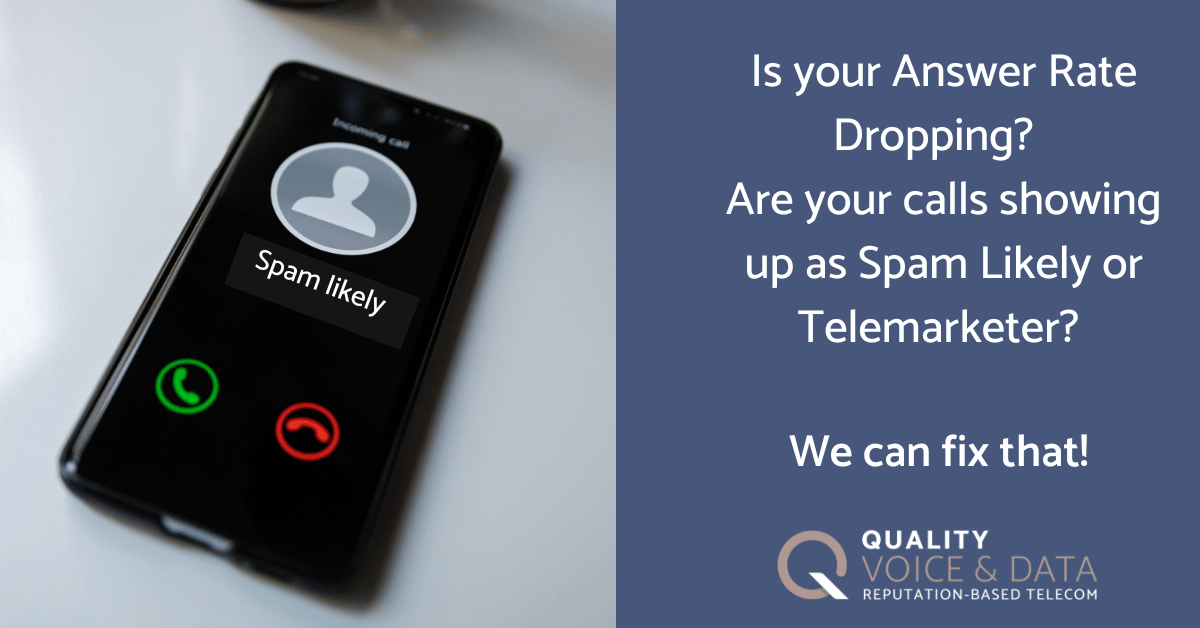The problem starts when almost no one picks up the phone when your business calls. Established customers will answer your calls. But others? Not so much––especially if you're calling their mobile phones. And then, after a while, you figure out why.
Your calls are being marked as "Scam Likely" or "Telemarketer."
Why does this happen? And what can you do about it? This blog post has the answers for you.

Why Do Calls Get Marked as Scam Likely or Telemarketer?
In the past few years, we've all become familiar with this scenario: your phone rings, and the caller ID display says "Scam Likely" or "Telemarketer." You don't want waste your time, so you don't answer the call.
These caller ID labels are the result of efforts from the Federal Communications Commission (FCC) to fight spoofed robocalls. In March 2020, the FCC mandated that telecom carriers deploy the STIR/SHAKEN standard to help protect consumers against robocalls, scams, and unwanted phone calls.
What is STIR/SHAKEN?
STIR/SHAKEN is a catchy acronym for the caller ID authentication technology used by the telecom industry. It's comprised of two standards: Secure Telephone Identity Revisited (STIR) and Signature-based Handling of Asserted Information Using toKENs (SHAKEN). STIR/SHAKEN provides a method for calls traveling through phone networks to have their caller ID information signed by the originating carrier and validated by other carriers on its way to the destination phone number.
Once a call reaches your phone company's network, STIR/SHAKEN allows your phone company to verify that a call is, in fact, from the number displayed on the caller ID. If it's not, it may be marked as "Scam Likely" or "Spam." If STIR/SHAKEN has determined the caller ID belongs to a telemarketer, that info will be displayed. Mobile phones can also act on STIR/SHAKEN info and take actions set by the user, like silencing spam calls or sending them straight to voicemail.
How Do Phone Numbers Get Flagged?
Outbound phone numbers can get flagged one of two ways. One way is when a consumer blocks your number with a call-blocking app, and the other is when a carrier flags you for making too many outbound calls.
The good news is that a single consumer blocking your number with a call-blocking app generally does not get you flagged by STIR/SHAKEN. Multiple blocks, however, can lead to your number being marked as "Spam," "Scam," or even "Nuisance Call."
Carriers use thresholds to flag numbers. Each carrier's thresholds are different, but they will generally be set as so many calls per minute or day. If a carrier's systems determine that a dialer, not a human, is the source of many calls, then a flag is more likely to be applied.
How Does This Affect Your Business?
As a consumer, you probably appreciate being alerted to spam calls. But when it comes to your business, that's another story. Caller ID verification isn't perfect, and it can lead to your legitimate phone activity being flagged.
If your business uses any type of dialer, your number could be incorrectly marked as a "Scam" or "Spam." When you're calling mobile numbers, the phone on the other end may not even be ringing until the owner adds your number as a contact.
If your phone number has been flagged by STIR/SHAKEN or one of the many phone companies, there is no process to get your caller ID info cleaned up. The best way to prevent your calls from being blocked and labeled is to use a telecom carrier with a high attestation level.
What Are Attestation Levels?
STIR/SHAKEN verifies callers by assigning a verification token based on a caller's attestation level. Attestation levels are the caller ID system's way of verifying that a caller is who they say they are and that their calls are for legitimate purposes.
The attestation levels, from highest to lowest, are:
1. A (Full Attestation): An A attestation means that the service provider has verified the caller's identity by signing the call with their digital certificate.
2. B (Partial Attestation): A B attestation means the service provider has verified the caller's identity but has not signed the call with their digital certificate.
3. C (Gateway Attestation): A C attestation means the service provider has not verified the caller's identity.
Quality Voice & Data is the Solution for Your Business Calls
The best way to prevent your calls from being blocked and labeled is to use a telecom carrier that will ensure your calls are signed with the highest attestation level. Quality Voice Data is the service provider that will do that for your business and more.
As a SHAKEN Telecom Service Provider that signs all calls with an A Attestation, we also go a step further and monitor each caller ID number utilized by our customers. We're watching how the analytics databases assess the call activity from each of our customers’ caller ID numbers. To make all your business calls without worrying about being blocked and flagged, get in touch with us or check out our Trusted Call Completion® solution today!
Angela Garfinkel, Director at Quality Voice and Data, brings over 30 years of experience in call center and business process outsourcing. Well known in the telemarketing and telecommunications industry, she co-authored a course for The Direct Marketing Association and actively participates in professional groups like PACE. Her educational background includes an MBA and an undergraduate degree in Telecommunications Management from the University of Nebraska.

